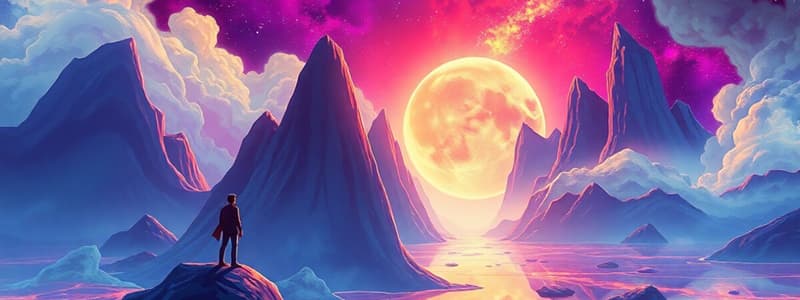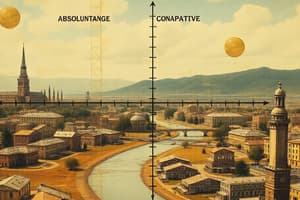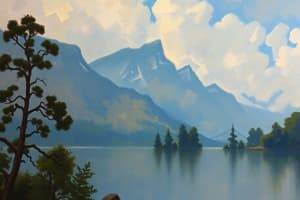Podcast
Questions and Answers
Dans le contexte de la science économique, laquelle des questions suivantes est fondamentale?
Dans le contexte de la science économique, laquelle des questions suivantes est fondamentale?
- Comment minimiser l'impact environnemental de la production?
- Comment les individus maximisent-ils leur bonheur personnel?
- Quand faut-il investir dans les marchés boursiers mondiaux?
- Que produire, comment produire et pour qui produire? (correct)
Si une nation décide de produire davantage de biens de consommation, quel est le compromis le plus probable?
Si une nation décide de produire davantage de biens de consommation, quel est le compromis le plus probable?
- Une augmentation des exportations.
- Une réduction de la production de biens de production. (correct)
- Une diminution des dépenses publiques.
- Une baisse des taux d'intérêt.
Parmi les suivants, quel exemple représente le mieux un bien ou service gouvernemental?
Parmi les suivants, quel exemple représente le mieux un bien ou service gouvernemental?
- Une application mobile payante.
- Un programme de défense nationale. (correct)
- Une voiture de sport de luxe.
- Un service de consultation privée.
Lequel des éléments suivants est considéré comme un agent économique?
Lequel des éléments suivants est considéré comme un agent économique?
Dans un système économique, comment la production est-elle distribuée?
Dans un système économique, comment la production est-elle distribuée?
Lequel des énoncés suivants décrit le mieux une économie de marché?
Lequel des énoncés suivants décrit le mieux une économie de marché?
Quelle est la principale différence entre une économie planifiée et une économie de marché?
Quelle est la principale différence entre une économie planifiée et une économie de marché?
Si un pays adopte une économie mixte, quelles décisions économiques sont susceptibles d'être prises par l'État?
Si un pays adopte une économie mixte, quelles décisions économiques sont susceptibles d'être prises par l'État?
Quel économiste est le plus souvent associé à l'école de pensée classique?
Quel économiste est le plus souvent associé à l'école de pensée classique?
Quelle est la caractéristique principale de l'école de pensée marxiste?
Quelle est la caractéristique principale de l'école de pensée marxiste?
L'école de pensée keynésienne préconise quelle intervention de l'État dans l'économie?
L'école de pensée keynésienne préconise quelle intervention de l'État dans l'économie?
Quel est le but principal d'un modèle économique comme la CPP?
Quel est le but principal d'un modèle économique comme la CPP?
Dans une économie où la production est limitée à l'or et aux arbres, quel est l'impact d'une découverte de nouvelles mines d'or?
Dans une économie où la production est limitée à l'or et aux arbres, quel est l'impact d'une découverte de nouvelles mines d'or?
Si une épidémie réduit la main-d'œuvre disponible dans une économie produisant de l'or et des arbres, comment la CPP est-elle affectée?
Si une épidémie réduit la main-d'œuvre disponible dans une économie produisant de l'or et des arbres, comment la CPP est-elle affectée?
Dans le contexte de la CPP, qu'indique un point situé à l'intérieur de la courbe?
Dans le contexte de la CPP, qu'indique un point situé à l'intérieur de la courbe?
Que représente un point situé sur la frontière de la CPP?
Que représente un point situé sur la frontière de la CPP?
Si une économie se situe initialement sur sa CPP, produisant uniquement de l'or, et décide ensuite de produire également des arbres, quel concept économique cela illustre-t-il?
Si une économie se situe initialement sur sa CPP, produisant uniquement de l'or, et décide ensuite de produire également des arbres, quel concept économique cela illustre-t-il?
Comment une amélioration technologique affectant positivement la production d'or et d'arbres serait-elle représentée sur la CPP?
Comment une amélioration technologique affectant positivement la production d'or et d'arbres serait-elle représentée sur la CPP?
Qu'est-ce que le coût de renonciation?
Qu'est-ce que le coût de renonciation?
Dans le contexte de la CPP, quand le coût de renonciation est-il dit croissant?
Dans le contexte de la CPP, quand le coût de renonciation est-il dit croissant?
Lequel des énoncés suivants illustre le mieux le concept du coût de renonciation?
Lequel des énoncés suivants illustre le mieux le concept du coût de renonciation?
Pourquoi le coût de renonciation est-il un concept omniprésent dans la vie économique?
Pourquoi le coût de renonciation est-il un concept omniprésent dans la vie économique?
Dans le modèle de la CPP, comment représente-t-on une situation où une économie n'utilise pas toutes ses ressources disponibles?
Dans le modèle de la CPP, comment représente-t-on une situation où une économie n'utilise pas toutes ses ressources disponibles?
Si une économie se déplace le long de sa CPP vers un point où elle produit plus d'un bien et moins d'un autre, qu'est-ce qui reste constant?
Si une économie se déplace le long de sa CPP vers un point où elle produit plus d'un bien et moins d'un autre, qu'est-ce qui reste constant?
Quel facteur pourrait causer un déplacement de la CPP vers l'extérieur?
Quel facteur pourrait causer un déplacement de la CPP vers l'extérieur?
Comment la spécialisation des facteurs de production influence-t-elle la forme de la CPP?
Comment la spécialisation des facteurs de production influence-t-elle la forme de la CPP?
Dans une économie qui peut produire uniquement des biens X et Y, une amélioration de la technologie de production du bien X uniquement entraînerait:
Dans une économie qui peut produire uniquement des biens X et Y, une amélioration de la technologie de production du bien X uniquement entraînerait:
Quelle est la conséquence d'une allocation inefficace des ressources dans une économie, en termes de CPP?
Quelle est la conséquence d'une allocation inefficace des ressources dans une économie, en termes de CPP?
Si un gouvernement impose des réglementations environnementales strictes qui augmentent les coûts de production de toutes les entreprises, comment cela affectera-t-il la CPP du pays?
Si un gouvernement impose des réglementations environnementales strictes qui augmentent les coûts de production de toutes les entreprises, comment cela affectera-t-il la CPP du pays?
Dans le contexte des écoles de pensée économique, laquelle met l'accent sur l'importance de la demande globale et de l'intervention gouvernementale pour stabiliser l'économie?
Dans le contexte des écoles de pensée économique, laquelle met l'accent sur l'importance de la demande globale et de l'intervention gouvernementale pour stabiliser l'économie?
Comment une économie peut-elle atteindre un point situé au-delà de sa CPP actuelle?
Comment une économie peut-elle atteindre un point situé au-delà de sa CPP actuelle?
Une entreprise doit choisir entre investir dans de nouvelles machines ou former ses employés. Quel concept économique illustre le mieux cette situation?
Une entreprise doit choisir entre investir dans de nouvelles machines ou former ses employés. Quel concept économique illustre le mieux cette situation?
Quel est l'impact d'une guerre sur la CPP d'un pays?
Quel est l'impact d'une guerre sur la CPP d'un pays?
Flashcards
Central Economic Questions
Central Economic Questions
These are the four fundamental questions that economics seeks to answer due to limited ressources and unlimited wants.
Consumption Goods
Consumption Goods
Goods and services purchased by households for direct consumption.
Production Goods
Production Goods
These are goods used to produce other goods or services, also known as physical capital.
Government Goods
Government Goods
Signup and view all the flashcards
Export Goods
Export Goods
Signup and view all the flashcards
Economic Agents
Economic Agents
Signup and view all the flashcards
Production Factors
Production Factors
Signup and view all the flashcards
Rationing Mechanism
Rationing Mechanism
Signup and view all the flashcards
Mixed Economy
Mixed Economy
Signup and view all the flashcards
Planned Economy
Planned Economy
Signup and view all the flashcards
Market Economy
Market Economy
Signup and view all the flashcards
Classical Economics
Classical Economics
Signup and view all the flashcards
Marxist Economics
Marxist Economics
Signup and view all the flashcards
Keynesian Economics
Keynesian Economics
Signup and view all the flashcards
Economic Model
Economic Model
Signup and view all the flashcards
CPP First Assumption
CPP First Assumption
Signup and view all the flashcards
CPP Second Assumption
CPP Second Assumption
Signup and view all the flashcards
Attainable Combinations
Attainable Combinations
Signup and view all the flashcards
Unattainable Combinations
Unattainable Combinations
Signup and view all the flashcards
Full Employment
Full Employment
Signup and view all the flashcards
Underemployment
Underemployment
Signup and view all the flashcards
PPF Curve Shift Outward
PPF Curve Shift Outward
Signup and view all the flashcards
PPF Curve Shift Inward
PPF Curve Shift Inward
Signup and view all the flashcards
Point Shift on PPF
Point Shift on PPF
Signup and view all the flashcards
Opportunity Cost
Opportunity Cost
Signup and view all the flashcards
Opportunity Cost Characteristics
Opportunity Cost Characteristics
Signup and view all the flashcards
Increasing costs
Increasing costs
Signup and view all the flashcards
Ubiquitous Cost
Ubiquitous Cost
Signup and view all the flashcards
Study Notes
- Week 2 will cover basic vocabulary and the PPF (Production Possibilities Frontier).
Review of Last Week
- Covered economy and economics and the role of the economist.
- Discussed positive vs. normative approaches.
- Outlined microeconomics vs. macroeconomics.
Topics for This Week
- The four central questions in economics.
- Schools of thought in economics.
- The PPF as a model to illustrate basic vocabulary.
The Four Central Questions in Economics
- The four central questions in economics are:
- What to produce?
- For whom to produce?
- How to produce?
- How to distribute production?
- Decisions aremade given our resources are limited and needs are unlimited
What to Produce?
- It is essential consider the categories of goods and service, including:
- Consumer Goods, such as automobiles.
- Production Goods (physical capital) like a factory/assembly line.
- Governmental Goods & Services, such as public services.
- Export Goods, such as Aluminum.
For Whom to Produce?
- The important agents to consider for whom to produce are:
- Consumers (households).
- Producers (businesses).
- Government.
- Other countries.
Economic Agent Relationships
- Economic agents consistently exchange resources to meet their needs.
How to Produce?
- How to produce involves understanding Factors of Production including:
- Land (raw materials) such as water, metals, oil.
- Labor (human capital) consists of employees or expertise.
- Production Goods (physical capital) refers to factories or assembly lines.
- Distinguish factors of production from production goods.
How to Distribute Production?
- Production gets distributed through a rationing mechanism.
- Rationing mechanisms include the following
- Price
- Queuing/waitlists.
- Central authority.
- Randomness (e.g., lottery).
Economic Systems
- Each society decides how to answer the four fundamental questions of economics through its economic system.
- Economic systems includes planned, market, and mixed economies:
- In a mixed economy are made by interactions between producers and consumers, and the government.
- Market economies production decisions are made through interactions between producers and consumers
- In planned economies production decisions are made by the government.
Schools of Thought In Economics
- Many economic choices depend on a school of thought, such as which economic system to choose, how to distribute taxes, and what economic interventions the government should prioritize.
- Economic school of thought can be associated with:
- A dominant characteristic.
- A system of economy.
- An economic thinker of mark.
Classical Economics
- Classical economics supports free markets and private property rights.
- Market economy is the associated economic system.
- Minimal government intervention in markets is a dominant characteristics
- Prominent classical economist is Adam Smith (1723-1790)
Marxist Economics
- Marxist school of thought advocates removing private property and collectivizing production factors.
- Planned economy goes hand in hand with Marxist economics
- Controlling markets by the state is a dominant characteristic
- Key intellectual figure associated with this school of thought is Karl Marx (1818-1883).
Keynesian Economics
- Keynesian economics supports government intervention to regulate markets without eliminating them
- Mixed economy as its matching economic system.
- The state regulation markets
- Economic thinker associated with this school of thought is John Maynard Keynes(1883-1946)
The Production Possibilities Frontier (PPF)
- The PPF is a model to illustrate core concepts in basic vocabulary.
- Models simplify reality to illustrate a complex notion.
Model Basis
- Models are made based on assumptions to make reality simpler.
- The Production Possibility Frontier (PPF) has two assumptions:
- It exists in a fictitious economy exclusively producing two resources.
- Production factors for those two goods are not similar.
Production Possibilities
- Tables illustrate an economy's production possibilities over a given period.
- An economy can decide to:
- Produce only gold.
- Produce only trees.
- Produce multiple combinations of both resources.
PPF Graph Illustration
- Points are connected and identified
- Axes should have units of measurements
- Title: PPP of (place's name)
PPF Analysis
- Points inside or along the border correspond to possible (realistic) combinations.
- Border-exterior points represent combinations that are not possible (unrealistic).
Full vs. Under Employment
- Points on the PPF boundary demonstrate efficient combinations.
- Inside points show inefficient combinations.
- It will not be possible to reach the points on the frontier if half of the economy's population is unemployed.
PPF Shifts
- The PPF will shift with any events that affect production prospects in an economy.
- The PPF shifts inward as production prospects decline.
- The PPF shifts outward as production prospects increase.
- Shifts could be imbalanced were solely the production options of a certain products been affected.
- Example is a rain will slow down tree falling.
- Improved equipment enhances trees and gold manufacturing capacity.
- An epidemic cuts the gold labour reserve by a half.
Stable Productions
- If the production capabilities remains consistent while inhabitants change their production selection, the situation changes.
- Beginning at point A (gold production solely).
- Scenario one is inhabitants have the ability to work for half of the day and spend the moment relaxing.
- Scenario 2 is inhabitants change production and generate solely trees
Production Relocation
- If production possibilities stay stable and preferences shift, there is a point shift rather than a curl shift.
Increasing Production
- Increasing the production of one thing will result in a yield increase of said thing but with a loss of the other.
Opportunity Cost
- This yield can be referred by a opportunity cost name
- Moving from one dot to another is 1 unit of the yield and a cost of -3 unit
Characteristics of Opportunity Cost
- Opportunity cost is measured in terms of sacrificed resources.
- If the World of Warcraft economy wants to make more gold, its opportunity cost is the quantity of trees lost.
- At full employment and additional production will necessitate an opportunity cost
- An economy operating at less than full employment can increase output of one good will not sacrifice the other because the resources are underutilized.
Increasing Opportunity Cost
- Cost of Waiver is a growth on the CPP
- It is more expensive to produce an extra tree
- The model's second hypothesis (production capabilities aren't comparable) leads to this result.
- If more of one thing is produce, ineffective production capabilities are utilize
- Law of diminishing returns is how this affect is known
Renunciation Cost
- Trading costs are always there
- Choices include a sacrifice Examples contains:
- Accepting more time on a current employment has an cost of renunciation
- What is renounce if you decide to enter a new relationship
- Accepting a free meal will also come a cost of renounciation
Studying That Suits You
Use AI to generate personalized quizzes and flashcards to suit your learning preferences.
Related Documents
Description
Explore basic economics vocabulary and the Production Possibilities Frontier (PPF). Understand the four central questions in economics: what to produce, for whom to produce, how to produce, and how to distribute production. Learn about different categories of goods and services.




